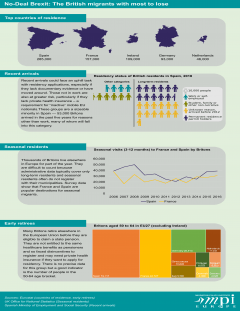The End of the Retirement Dream? British Pensioners in the European Union after Brexit
Approximately one-quarter of UK citizens living abroad in the EU-27 are thought to be pensioners—a proportion that could grow over time as current workers retire. As Brexit approaches, members of this group are likely to face challenges related to pension incomes, health care, and access to social assistance that could severely hamper their ability to maintain their current lifestyle in Europe.
Although many of the issues that Brexit raises for British pensioners will be shared by the wider British population of the EU-27, factors such as age, health, and fixed income leave pensioners more vulnerable to change than most. As they transition from being EU citizens to third-country nationals under EU law, UK pensioners will face unique issues. For example, will UK state pensions continue to increase in value for pensioners in the EU-27, as they do for those living in the United Kingdom? The answer is critical because without this uprating, pensions will stagnate and the risk of financial hardship and poverty will increase.
This issue brief explores the diversity of this pensioner population and the unique challenges they are likely to face after Brexit. It draws on 38 expert interviews with policymakers from seven EU Member States as well as a roundtable with UK officials and policy experts conducted in London. The brief It begins with a close look at the size and characteristics of the British pensioner population in the EU-27, before considering key Brexit-related policy questions and offering recommendations for both EU Member State and UK policymakers.
I. Introduction
II. A Profile of British Pensioners in Europe
A. Population Characteristics
B. Under- (and Over-) Registration
C. Dual Residency
III. Key Challenges after Brexit
A. Residency
B. Tax Residency
C. Pensions
D. Health Care
E. Other Forms of Social Assistance
IV. Policy Implications
A. Registration Systems
B. Return Intentions
V. Conclusions




